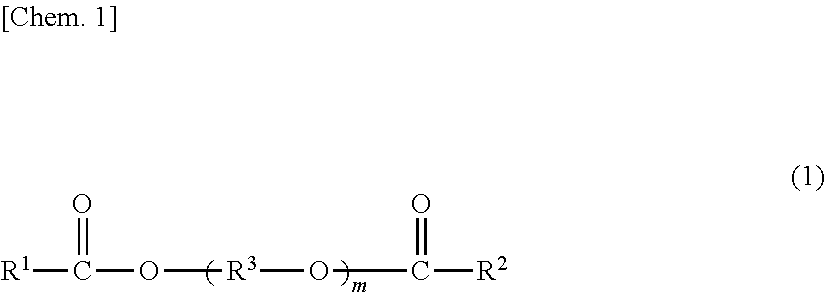Method for forming a multilayer paint film
a coating film and multi-layer technology, applied in the direction of coatings, transportation and packaging, synthetic resin layered products, etc., can solve the problems of low smoothness of coating film, low distinctness of image and the like, and insufficient water resistance of coating film, etc., to achieve excellent smoothness and distinct image
- Summary
- Abstract
- Description
- Claims
- Application Information
AI Technical Summary
Benefits of technology
Problems solved by technology
Method used
Image
Examples
production example 1
[0211]Eighty eight grams of adipic acid, 536 g of 1,2-cyclohexanedicarboxylic acid anhydride, 199 g of isophthalic acid, 288 g of 2-butyl-2-ethyl-1,3-propanediol, 95 g of neopentylglycol, 173 g of 1,4-cyclohexane dimethanol, and 287 g of trimethylolpropane were placed into a reaction vessel equipped with a thermometer, a thermostat, a stirrer, a reflux condenser and a water separator, and heated from 160° C. to 230° C. over a period of 3 hours. The reaction was maintained at 230° C. while removing the condensation water using a water separator, and was allowed to proceed until the acid value became 5 mg KOH / g or less. Trimellitic anhydride (86 g) was added to the reaction product, and an additional reaction was performed at 170° C. for 30 minutes. Subsequently, the result was cooled to 50° C. or less, and neutralized by adding 0.9 equivalents of 2-(dimethylamino)ethanol relative to acid groups. Then, deionized water was gradually added to obtain a hydroxy- and carboxy-containing pol...
production examples 2-18
[0218]According to the proportions shown in Table 1 below, hydroxy- and carboxy-containing polyester resin aqueous dispersions (A-2) to (A-18), each having a solids content of 45% and a pH of 7.2 were obtained in the same manner as in Production Example 1. Table 1 shows the hydroxy value, acid value, number average molecular weight, content of the C4 or higher linear alkylene group, and total amount of the benzene ring and the cyclohexane ring of each of the resulting hydroxy- and carboxy-containing polyester resins, along with the values of the hydroxy- and carboxy-containing polyester resin aqueous dispersion (A-1) obtained in Production Example 1.
TABLE 1Production Example123456789Hydroxy- and carboxy-containing polyester resinA-1A-2A-3A-4A-5A-6A-7A-8A-9aqueous dispersionAcidAliphaticAliphaticAdipic acid8888888888888888componentpolybasicdicarboxylic(Mw: 146)(a-1)acidacidDodecanedioic acid276(a-1-1)containing(Mw: 230)C4 orhigher linearalkylenegroupAlicyclic polybasic acid1,2-Cycloh...
production example 19
[0219]A 30 part quantity of propylene glycol monopropyl ether was placed into a reaction vessel equipped with a thermometer, a thermostat, a stirrer, a reflux condenser, a nitrogen inlet tube and a dropping funnel, and heated to 85° C. A mixture of 10 parts of styrene, 30 parts of methyl methacrylate, 15 parts of 2-ethylhexyl acrylate, 11.5 parts of n-butyl acrylate, 30 parts of hydroxyethyl acrylate, 3.5 parts of acrylic acid, 10 parts of propylene glycol monopropyl ether and 2 parts of 2,2′-azobis(2,4-dimethylvaleronitrile) was added dropwise into a flask over a period of 4 hours, and then aged for 1 hour. A mixture of 5 parts of propylene glycol monopropyl ether and 1 part of 2,2′-azobis(2,4-dimethylvaleronitrile) was further added dropwise into a flask for 1 hour, and after completion of the dropwise addition, aging was conducted for 1 hour. Subsequently, 3.03 parts of 2-(dimethylamino)ethanol was added to the reaction product. Deionized water was gradually added to thereby obta...
PUM
| Property | Measurement | Unit |
|---|---|---|
| Percent by mass | aaaaa | aaaaa |
| Percent by mass | aaaaa | aaaaa |
| Percent by mass | aaaaa | aaaaa |
Abstract
Description
Claims
Application Information
 Login to View More
Login to View More - R&D
- Intellectual Property
- Life Sciences
- Materials
- Tech Scout
- Unparalleled Data Quality
- Higher Quality Content
- 60% Fewer Hallucinations
Browse by: Latest US Patents, China's latest patents, Technical Efficacy Thesaurus, Application Domain, Technology Topic, Popular Technical Reports.
© 2025 PatSnap. All rights reserved.Legal|Privacy policy|Modern Slavery Act Transparency Statement|Sitemap|About US| Contact US: help@patsnap.com

